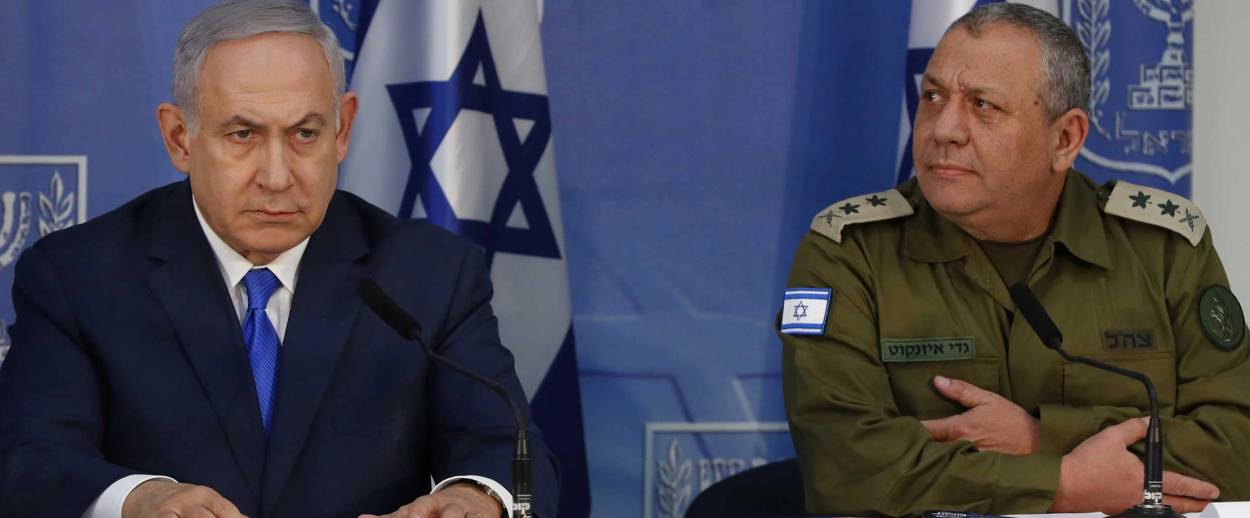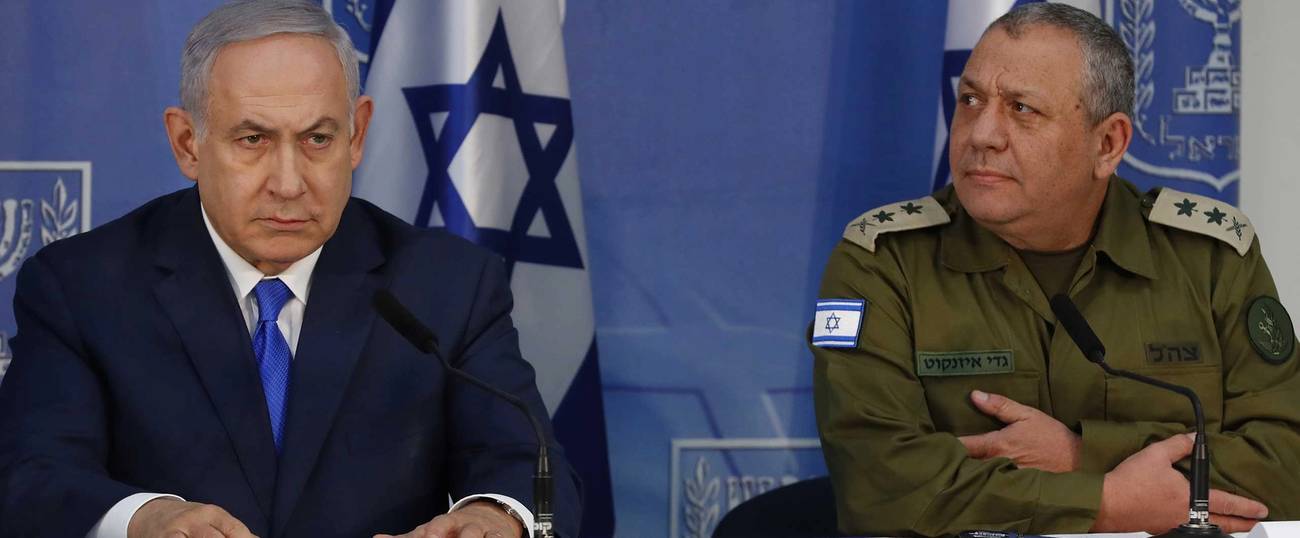The Curtain Is Falling on Bibi’s Lebanese Belly Dance
What lies beneath seven years of Israeli rhetoric about Iran?




For seven years, Israeli Prime Minister Benjamin Netanyahu has stridently warned Israel’s citizens and the world of a multipronged Iranian threat to his nation’s security and strategic position. And there is no shortage of evidence to suggest that the Iranian threat, which Netanyahu often speaks of in openly apocalyptic terms, is as real as it is grave.
Over the past several days, the Israel Defense Forces (IDF) have been uncovering and neutralizing a series of attack tunnels crossing from Lebanon into Israel—an operation likely to go on for many weeks. These tunnels are part of Hezbollah’s declared military plan to infiltrate and possibly hold positions in the Galilee in the next war with Israel.
Strategically, though, the tunnels are the lesser part of the threat that is being posed to Israel by Iran and its proxies. The more pressing element is Hezbollah’s missile capability. Specifically, with Iranian assistance, Hezbollah has embarked on what Israeli officials refer to as the “missile precision project”—an effort to upgrade its large arsenal of rockets with guidance systems, increasing their accuracy, and thereby changing the severity of the threat they pose.
Iran and Hezbollah have been developing and deploying their guided missile project both in Lebanon and Syria, where, over the past seven years, the Iranians and Hezbollah have increased their military deployment and entrenchment. Iranian-led and Hezbollah forces and infrastructure are now positioned throughout Syria, in key strategic areas including along the Lebanese-Syrian and Iraqi-Syrian borders, as well as in southern Syria, near the border with Israel. It is clear that the combined threat of Iran’s positioning on Israel’s northern borders with Lebanon and Syria—as well as Gaza—is a strategic one. Just look at a map.
The question of whether Israel’s current actions to uncover and dismantle Hezbollah’s cross-border tunnels, dubbed Operation Northern Shield, is a preface to a larger action to neutralize the Iranian threat the Israeli government has been warning about is harder to answer.
Israel’s dilemma over the past decade has been whether to go to war with Hezbollah now or later, when its security environment has deteriorated even further. The Israeli government’s answer to this dilemma so far has been to continue to buy time by reducing as much as possible the growth in Hezbollah’s capabilities, which have increased notably over that time, during which Israel has enjoyed a burst of economic growth unprecedented in the country’s history.
One reason that the peace has been kept so far is the Syrian War. As the war intensified, Israel ramped up its operations targeting Hezbollah and Iranian assets and personnel inside Syrian territory, turning Syria into a cost-free kill zone for the Israel Air Force (IAF). The Russian deployment in the country in late 2015 did not stop IAF activity—nor is Russia’s recent deployment of S-300 anti-air missile batteries likely to much affect Israel’s ability or willingness to hit Iranian targets inside Syria.
There’s no question that IAF action in Syria has been effective, not just in targeting weapons shipments arriving at Damascus airport, or in transit to Lebanon, but also in hitting facilities in Syria used by Iran and Hezbollah to upgrade missile accuracy. But there was a catch to Israel’s freedom of action inside Syria: If Iran and Hezbollah had little choice but to absorb Israeli strikes in Syria, hitting targets inside Lebanon would precipitate retaliation. As Israel worked to reduce the threat from Syria, the threat from Lebanese soil therefore continued to grow.
Israel has understood and accepted this equation. With but two exceptions over the past seven years, Israel has refrained from striking inside Lebanese territory, while Lebanon never stopped being Hezbollah’s and Iran’s operational headquarters.
In early 2017, there were reports of Iran and Hezbollah having set up production and assembly facilities in Lebanon to upgrade the group’s rockets—an effort that had begun the year before. While their operations in and through Syria continued, Iran and Hezbollah amplified their project in Lebanon as well. Soon, it became routine to see reports, citing U.S. and Western intelligence sources, of Iranian flights carrying arms and components for the missile upgrade facilities in Lebanon, landing directly in Beirut Airport.
These moves are the logical result of the agreement to keep Lebanon off limits. As Israel refrained from taking action in Lebanon for the past seven years, with the expressed recognition that to do so could, or likely even would, trigger a war, Hezbollah interpreted Israel’s decision as a form of effective deterrence. Sure, Netanyahu publicized Hezbollah’s missile facilities at the United Nations in September, and warned that Israel would not let them get away with it. But as of yet, not one missile facility or Iranian plane inside Lebanon has been blown up as they have in Syria. Now, Hezbollah is pushing the envelope, stretching the limits of the prevailing equation as far as they will go.
Which brings us back to Operation Northern Shield. There are two ways to read the operation. The first possibility is that Israel is setting the stage for military action, at the diplomatic level, by highlighting Hezbollah’s activities and the failure of the United Nations Interim Force in Lebanon (UNIFIL) and the Lebanese government to stop them, as well as at the military level, by neutralizing an integral part of Hezbollah’s strategy for the next conflict. Like the publicizing of the missile facilities and the Iranian flights to Beirut Airport, this is all part of the necessary preparatory work ahead of any military campaign. For instance, if UNIFIL and the Lebanese government fail to dismantle the tunnels inside Lebanon and Israel is forced to do so by itself, and Hezbollah attacks, then the political legwork already will have been done, and the onus for any wider conflict will be on Hezbollah and Iran.
The other possibility is that the operation falls within the framework of the past seven years, meaning that it aims to diminish Hezbollah’s capabilities and thus forestall a larger conflagration. As evidence for this possibility, one could point to reports of Israel’s advance warnings to Lebanon and to Hezbollah ahead of the operation, its decision, so far, to limit the operation to the Israeli side of the border while calling on UNIFIL to handle the Lebanese side, and its reported reassurances to Lebanon about its intention to avoid any escalation. This would fall in the category of calling on “the international community” to take action before Israel is forced to, a gesture whose goal is to buy time within the existing status quo.
But it’s entirely unclear whether Israel truly believes “the international community,” or, let’s be serious, the United States, will take action, and, if so, what that action might be. It’s not as though the United States has not been aware of the Iranian flights or the missile facilities, for example. In fact, over the past seven years, “preserving Lebanon’s stability” has been the declared U.S. policy, which dovetailed with Israel’s and Hezbollah’s de facto agreement to sideline Lebanon and focus on Syria. By “preserving Lebanon’s stability,” the United States allowed Hezbollah to shield itself and its activities in, and from, the country.
The paradox of current U.S. policy of “preserving the stability” of a country whose politics and armed forces are directly controlled by an Iranian terror group has created an open political farce. The two pillars of Washington’s policy of “stability” in Lebanon, UNIFIL and the Lebanese Armed Forces (LAF), have been shown to be at best an embarrassing failure. At worst, they show the institutions of the Lebanese state to be actively shielding and facilitating Hezbollah’s military buildup. Not only were the tunnels that Israel is now destroying dug literally under UNIFIL’s nose, but Beirut Airport, where the Iranian flights are landing, is guarded by the LAF.
The premise of the current U.S. policy of distinguishing between the bad Hezbollah and the good “Lebanese government,” which might have once been seen as a noble fiction, is now an open joke. But the reality is, nobody other than Israel is going to do anything about it. The approach of the past seven years—that Israel can focus its operations on Syria and avoid them in Lebanon—is reaching the end of the line, if it hasn’t expired already.
With Iran and Hezbollah holding their positions in Syria, and no longer concerned about the collapse of their Syrian client Bashar Assad, the Lebanon problem is now firmly back at center stage. Hezbollah and its Lebanese government are betting the bipartisan embrace by U.S. policymakers of the fiction of Lebanese state institutions, which in reality are controlled by and provide institutional cover for Hezbollah, will complicate any Israeli decision to act against the strategic threat being posed by Iran. On the other hand, it seems unlikely that Israel will accept a large arsenal of guided missiles controlled by Iran and targeting its major population centers and strategic sites as part of a new regional status quo.
Instead of confining itself within Hezbollah’s preferred rules of engagement, and thereby cementing the group’s dangerous delusion that it has achieved deterrence—a delusion that is likely to lead to further aggression—Israel might consider throwing the ball in Hezbollah’s court. If they think they’re immune in Lebanon, even now that the Syrian war is decided, they should think again. If Hezbollah then chooses to escalate by provoking another conflict, they would invite a devastating thrashing, along with the destruction of considerable portions of Lebanese infrastructure, all while Iran reels under sanctions.
In May, Netanyahu spelled out the choice Israel faces in clear terms: “We don’t want confrontation, but if there needs to be one, it is better now than later.” While the political and PR risks of such a conflict are very real, as are the lives of Israeli civilians, to say nothing of the Lebanese who are being used as human shields by Iran and Hezbollah, they would only worsen with a large alteration of the strategic status quo in Iran’s favor, which is likely to lead to an exponentially greater loss of life on the Israeli side of the border.
Alternatively, Netanyahu might well opt to kick the can down the road one more time. But he is running out of road.
***
Like this article? Sign up for our Daily Digest to get Tablet magazine’s new content in your inbox each morning.
Tony Badran is Tablet’s news editor and Levant analyst.